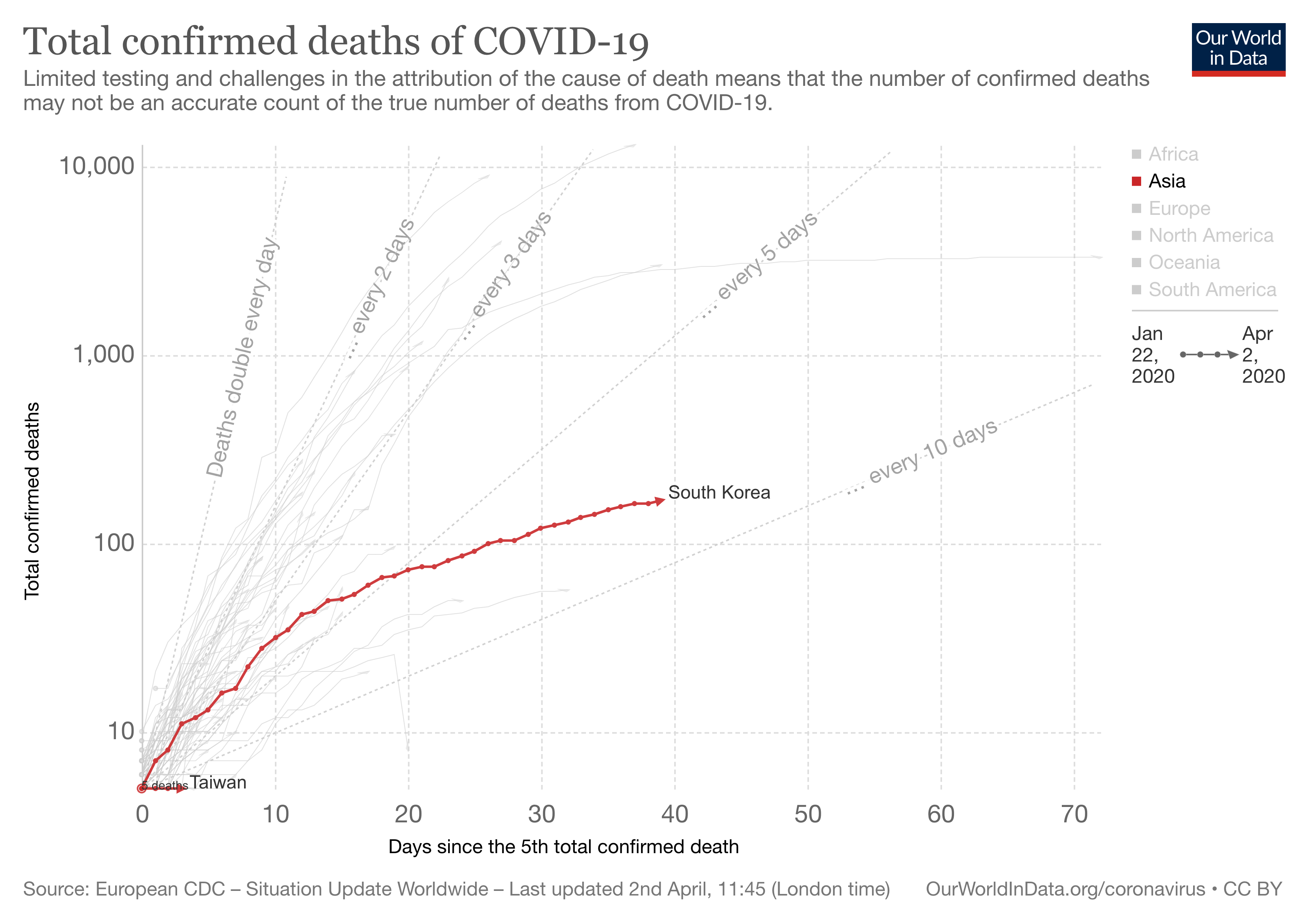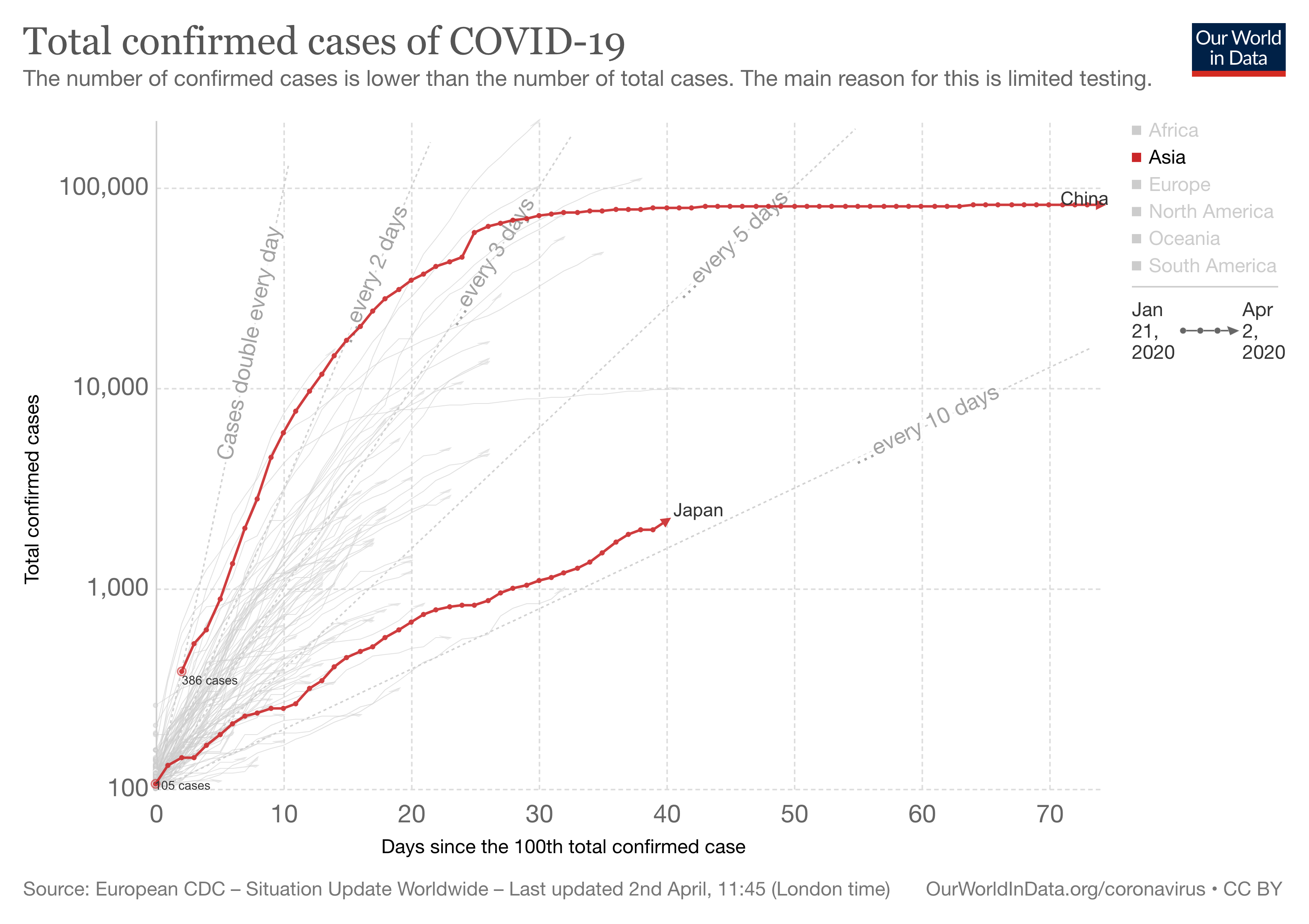Many of us feel depressed about the COVID-19 situation, and it is without doubt a horrible tragedy.
But millions
of people are rising to the occasion, and there’s a lot of good news mixed in
with the bad.
The media has
a tendency to give extra coverage to bad news, because readers find negative
stories more eye-catching.
So in the
interest of balance, here are some positive things we’ve learned in the last
week while writing articles on how to tackle the corona-virus crisis
through temporary work, donations,
or policy, and
compiling over 250 job opportunities and 60 funding sources.
Some countries are turning COVID-19 away at the door, while
others are turning the tide of the pandemic
As you can
see in this chart, COVID-19 remains mostly controlled in South Korea, Taiwan
and Singapore. Taiwan is barely visible down there at the bottom, while
Singapore actually hasn’t had enough deaths to make it onto the figure yet.

Once they
emerge from their ‘lock-downs’, other places can potentially copy the methods
which these three countries have shown can work.
COVID-19 may
also be controlled in Hong Kong, Japan and China, which are reporting few new
cases. (Unfortunately, Hong Kong and Japan aren’t testing enough people to be
sure, and China doesn’t say how many tests it’s running, so we’ll have to wait
and see.)

As the figure
below shows, even the two worst affected countries, Spain and Italy, are seeing
the rates of increase for new cases and deaths decline.

Italy adopted
a full national lock-down on March 9 and Spain did the same on March 14.
The number of people dying each day has been stable in Italy for the
last ten days, and has been growing much more slowly in Spain for the last
eight.
In fact most
countries that engage in this level of physical isolation are seeing the rate
of new cases level off or decline 1-3 weeks later, as we hoped and expected.
Consistent
with that, researchers at the London School of Hygiene and Tropical Medicine
just estimated that the reproductive rate of the corona-virus in the
UK is now below 1, thanks to people mostly staying at home. If that’s correct
the number of new cases will level off and then decrease over the next 6 weeks.
It might kill fewer people than we thought
We aren’t
sure how many people who become infected with COVID-19 die, but on
March 31 the Oxford Centre for Evidence Based Medicine (CEBM) reduced their
best-guess estimate from 0.51% down to 0.1–0.26%.
Among other
things, they think some people who have been classified as dying of COVID-19
didn’t actually die of the disease but rather of serious existing conditions,
and they just happened to have COVID-19 when they died.
0.1–0.26% is
lower than most other expert estimates. Frankly it’s also a lot lower than my
best guess.
But I’m
really hoping that the CEBM turns out to be right.
Testing is increasing rapidly in most countries
The US has
gone from testing 350 people on the 7th of March, to 30,000 people on the
19th of March, up to 101,000 on the 1st of April.
As the figure
below shows, among countries that release testing data, big increases like that
are common.

Tiny Iceland
has already tested almost 6% of their population, and is releasing
their data in a way that makes it very easy for others to analyse.
Supermarkets are refilling and hiring fast
Some people
have worried about whether we might end up unable to buy enough food, because
COVID-19 could interfere with trade and supermarket supply chains.
So far that
doesn’t seem to be happening. UK supermarket Tesco expects to be back to normal
stock levels within weeks.
In fact
they’ve hired 35,000 people in just the last ten days, which has helped them
expand delivery slots from 660,000 two weeks ago to 780,000 this week, with
plans for more big increases.
That seems
pretty typical of the solid job supermarket chains are doing handling this
crisis, and means fewer people will have to leave their homes to get groceries.
We’re learning what we need to know to respond intelligently
We’ll soon
know a lot more about what fraction of the population has or has had COVID-19,
something we’ve been very unsure about so far. This information is essential
when deciding our response, for example determining when it’s safe for people
to start leaving their homes more often.
Nearly-random
surveys of the general public, including people without any symptoms, are going
on in Austria, the US, Iceland, the UK, and probably many
other countries.
If you live
in the UK you can actually sign up to be tested in one of its studies here.
We’re making rapid technological progress on every front
For instance,
this week pharmaceutical firm Abbott Laboratories said it was
launching a test for the SARS-COV-2 virus that could take as little as five
minutes and “be run on a portable machine the size of a toaster”. German technology
company Bosch says it has done the same.
On Monday
Johnson & Johnson said it had identified a vaccine candidate and
the US government was investing $1 billion in its development.
Another group
is investigating ways to start human trials for vaccine candidates early, using
brave and willing volunteers, who haven’t been at all hard to find.
In March the
World Health Organisation launched a global ‘megatrial’ of four potential
treatments.
Stage 3
trials for remdesivir launched in the UK just this week. Remdesivir
was described in one paper as the most promising candidate antiviral
against COVID-19.
Finally, Modern
Therapeutics started doing human trials for a new kind of vaccine
back in mid-March. That’s the fastest the world has ever gone from identifying
a new disease to conducting vaccine trials in people.
It has been
inspiring to see the world come together to help fight this pandemic, whether
they are biologists, statisticians, engineers, civil servants, medics,
supermarket staff, logistics managers, manufacturers, or one of countless other
roles.
A further
piece of good news is that many of the innovations in policy, diagnostics and
treatment being pursued above will not only help us defeat COVID-19, but will
also leave us much better prepared for the next pandemic, whenever it arrives.
Good news about COVID-19
![Good news about COVID-19]() Reviewed by Muhammad Umar
on
May 07, 2020
Rating:
Reviewed by Muhammad Umar
on
May 07, 2020
Rating:






No comments:
Post a Comment